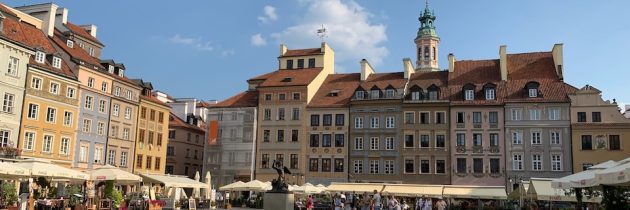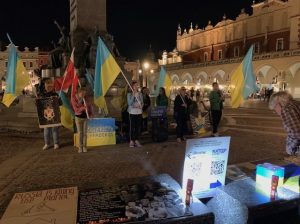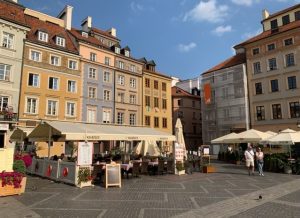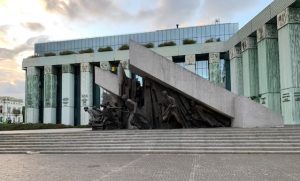Not a War Zone
When I told my mother I was traveling to Poland in September, she worried that I once again had chosen to vacation in a war zone. (For the “once again” part, please see the Author’s Notes for Torch and Surviving Santiago.) After all, a war has been raging in a neighboring country due to an aggressor that had occupied or colonized most of Eastern and Central Europe from 1918 to 1991. Poland shares a long border with Ukraine, an equally long one with Russian ally Belarus, and across the bay from Gdańsk, the Russian enclave of Kaliningrad.
Until the First World War, much of what is now Poland was under the thumb of the Russian Empire. After the conquest of the Polish-Lithuanian Commonwealth in the late eighteenth century, Austria-Hungary, Germany, and Russia divided the land between them, an occupation evident in the different architecture and culture of cities such as Krákow, Warsaw, and Gdańsk. November 11 marks the anniversary of Poland’s independence, which it regained in 1918 at the end of WWI after 123 years of subjugation. Unfortunately, the Bad Bear to the east and the Nazi regime to the west conspired to take away the country’s independence again, the event that started the Second World War in 1939. Poland went from Nazi subjugation during the war to Soviet subjugation at its end; the country was independent in name only from 1945 until the victory of the Solidarity movement in 1989.
This history of subjugation and resistance is evident everywhere in Poland, where independence and peace are ideals that must be fought for everyday. Poland is not a war zone, but monuments to past wars are everywhere — in museums, in public buildings (and even private ones like the former pharmacy that now houses Jakub Połkowski’s Lego exhibit), and on the streets. Walking from the Katyn Museum that honors the 22,000 Polish POWs murdered by their Soviet captors in WWII to the POLIN Museum of the History of Polish Jews at the site of the former Warsaw Ghetto, I passed a busy intersection with the Monument to the Fallen and Murdered in the East.
The following day I visited the Warsaw Rising Museum in another part of the city. For those who are confused by all the WWII Warsaw uprisings, as I was, here’s a quick summary. In 1943, the remaining residents of the Warsaw Ghetto, all Jewish, rose up against the Nazis after learning that the Ghetto would be liquidated and all of them sent to death camps. They had nothing to lose and fought to the death. Some escaped through the city’s sewers and joined the partisans hiding in forests or basements. Some of those fighters would return to the city in 1944 and join non-Jewish Poles who, as the Germans were retreating from the east, sought to liberate their city along with the advancing Soviet troops. However, the Soviet commanders chose not to support the resistance fighters of the Home Army, believing that if the Nazis slaughtered the Home Army, the Communist regime would have less opposition to taking over. Which is exactly what happened. Many consider the failed 1944 Warsaw uprising to be the first battle of the Cold War.
The Warsaw Rising Museum that day was filled with young military recruits on a field trip to learn about their country’s history, which includes the perfidy of the Soviet regime. In response to Russia’s full-scale invasion of Ukraine and threats to Poland’s independence — Putin’s right-hand man Dmitri Medvedev recently called Poland a “dangerous enemy” and warned of “the death of Polish statehood in its entirety” — the country is building up its military. I hope those young men and women at the museum never have to go to war, but they seemed to take their mission seriously as their officers walked them through the exhibits.
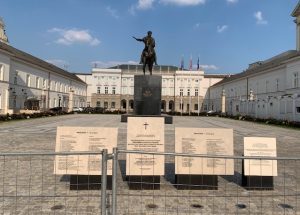
Near the Presidential Palace, a memorial to the former president and others killed in a 2010 plane crash on the way to Russia to commemorate the anniversary of the Katyn Massacre. Many Poles believe Russia downed the plane.
Poland has taken in more than a million Ukrainian refugees and has been one of the most outspoken countries in the EU and NATO in defending Ukraine’s right to exist. In the recent election, all of the competing parties with the exception of the far-right Konfederacja supported military aid to Ukraine, and Konfederacja received only 7% of the vote. Contrast that with the MAGA-dominated Republican Party in the U.S., with more than 40% support, that has pledged to end all aid for Ukraine, with party leader Trump and his allies openly expressing their support for aggressor Putin and Russia. When I see those young people in Poland learning about their history and their own role in it, I think how much we have to learn from them.
When I was a child and teenager growing up during the Cold War, my elders told me how fortunate I was to live in freedom, what so many people in the world — including those in Poland — did not have. I never thought as an adult that I would see so many people in my own country wanting to throw that freedom away. Today, Poland is not a war zone, but the lack of concern of its so-called allies for freedom, independence, national self-determination, international law, human rights, and, yes, good over evil makes war far more likely for those who have experienced such aggression in the past and live next door to it today.

